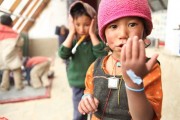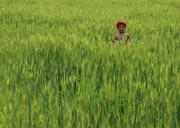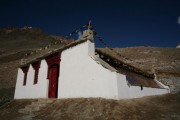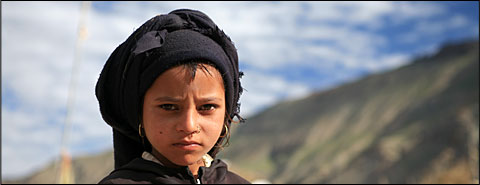A New School for a Himalayan Village
Eighty children from a Himalayan village Kargyak and neighboring settlements in the state Jammu and Kashmir in north India hope to sit in the school desks of a The Sun School in September this year. Thanks to the Czech volunteers. It will be the beginning of a first school year, when the classes will be held even during winter. It was a Czech Civil Association Surya, who came with the project of a school, heated by the sunrays.
Kargyak - a village at the end of the world
Kargyak, located 4200 meters above the sea level, is the highest situated village in the Zanskar region. Forty out of two hundred local people are school children. There is no school in the village today and only ten people are able to at least read and write. The closest school, providing tuition during the whole year, is in Raru, which is three days far-away. Therefore children from richer families leave to study in remote boarding schools. After they gain the education, only a few of them return back to their home village and this causes breakage of family bindings, which are the core of a local traditional culture.
The Sun School
Opening of the school in Kargyak enables education for the children of the village and its neighborhood. Tuition will go on even in winter, when farming work stagnates and the children have the best opportunity to attend the classes regularly. The school should also serve as a handcraft work-room, a meeting place for village council, as well as a weather station and a greenhouse will be set there. In summer, when the children help with the harvest, a dormitory for tourists will be here. The basis for the building design was the rough climatic conditions and the local traditions. More than 300 sunny days per a year in a high altitude allow the building to be constructed so that the sun energy utilization provides minimal temperature 15 °C during the whole year. That makes it possible to continue the tuition even during winter, when the temperature outside drops under 40 degrees Celsius.
From Honza's diary
Hope we finally have the right composition of a roof. That should be waterproof, though flat:-) Floor will be probably from a classical floor mixture - clay, cow dung and urine. We'll put straw matting on it, because wood is expensive and moreover - far. Now that I am talking about wood: it differs in every village. The same trees grow different time everywhere, a poplar tree 25 cm massive can grow between 3 and 12 years. In addition to that, the names of timber species are not even in the dictionary, so I guess I'll have to bring a log home with me:-) Also we found out that climatic measurement here hadn't been done yet. So when observing the rise of temperature, we rely on grandma Stenzin's narration. Once she used to clothe in a yak fur-coat since September, but nowadays she puts it on not until the end of October. Furthermore, the water in the kitchen doesn't freeze so often, which maintains our assumption about the warming.
The Work of Enthusiasts
The low-power building of the school for the Himalayan range was engineered as a diploma thesis on the Czech Technical University by Jan Tilinger. Nowadays, a team of volunteers prepares the release of the project straight on the place. Most of the building work will be done by the villagers themselves. Preliminary cost of the construction reaches up to 4.7 million Czech Crowns. The civil engineering project is to begin in spring 2007, opening of the school is planned for the autumn of the same year. The building will become the property of Kargyak village and will be state registered at Jammu and Kashmir.

 In now days are hppening big changes in Jammu and Kashmir.
https://www.bbc.com/news/world/asia/india
In now days are hppening big changes in Jammu and Kashmir.
https://www.bbc.com/news/world/asia/india  On September 21st, Kargyak Sun School will celebrate the 10th anniversary of its opening. There, in one of the last places on Earth, the original Tibetan culture survives at the elevation of 4200 m. Before the school opened, the village of 200 heads had only 10 members who could read and write a little. To get an education, children were sent away to boarding schools in faraway towns. Today, the Sun School has its alumni and thanks to the project, people stopped moving away from the village.
On September 21st, Kargyak Sun School will celebrate the 10th anniversary of its opening. There, in one of the last places on Earth, the original Tibetan culture survives at the elevation of 4200 m. Before the school opened, the village of 200 heads had only 10 members who could read and write a little. To get an education, children were sent away to boarding schools in faraway towns. Today, the Sun School has its alumni and thanks to the project, people stopped moving away from the village.  PRAHA 22.11.2018 | 19:00 Betlémská kaple
BRNO 21.11.2018 | 19:00 Milosrdní bratři
PRAHA 22.11.2018 | 19:00 Betlémská kaple
BRNO 21.11.2018 | 19:00 Milosrdní bratři 



